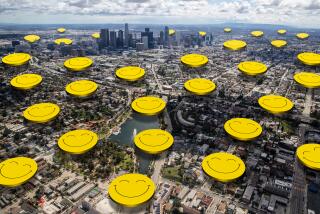Amid Busyness of Life, a Place to Reflect
Predictably, Orange County’s cradle of Zen is a block from a shopping mall, within earshot of a freeway and wedged between a couple of banal, black-glass office towers and a parking structure.
Isamu Noguchi’s California Scenario outdoor sculpture garden in Costa Mesa -- a collection of strategically placed boulders, stone, flowing water and trees -- is an acre and a half of tranquillity bobbing quietly on a sea of urban turmoil.
The internationally acclaimed artist built his homage to the serenity of California’s natural environment in the early 1980s with a commission from developer Henry Segerstrom that some believe topped $1 million. Noguchi, who was born in Los Angeles and lived much of his life in Japan and New York City, died in 1988 at 84.
For nearly a quarter-century, writers have mined the dictionary in search of the right words to describe this masterpiece plunked into an office park near South Coast Plaza. It’s been called surreal, spare and soothing. Poetic, primal and powerful. Mysterious, meditative and meaningful.
“It’s an oasis in all sorts of ways,” said Dickran Tashjian, retired chairman of UC Irvine’s art history department. “The theme of the garden is that in an urban society, with increasing mechanization and overrun by concrete and traffic, you can still get away from it all -- even if it’s just for a moment.”
Noguchi’s garden is a place to sit and think.
A place to stroll and reflect.
A place to stand and smoke.
Indeed, during the workweek, California Scenario becomes one of the world’s most expensive and aesthetically pleasing smoking lounges.
This surely was not part of Noguchi’s artistic vision. Yet at any given time between 9 and 5, most of the dozen or so people milling around the uneven stone walkways are doing so while sucking on coffin nails like Parisian art critics.
“On the weekends, you see a lot of people come with cameras, model shoots, packs of college kids with notepads,” said Bryan Greene, 36, who was taking a cigarette break before heading back to his job as a loan processor in one of the office buildings. “During the week, I’d say 95% of the people out here are smoking.”
“No,” countered co-worker Joe Hubbard, who had just stubbed out his smoke, “I’d say maybe 80% to 85%.”
California Scenario isn’t easy to find. A small sign on Anton Boulevard at Park Center Drive announces the garden and points you toward Jerry’s Famous Deli. The road leads to a parking structure, where the person in the booth will tell you where it is.
The main avocation at California Scenario is reflection. Here is California in metaphor, its deserts represented by a cactus garden on a dome of pebbles, its forests by nine towering redwoods around a sloping granite walkway. There’s a fountain made from granite and steel, and huge boulders scattered about like sleeping NFL linemen.
Two pyramids are connected by a waterfall and a rock-filled creek that winds around the plaza. Noguchi called the pyramids Water Source and Water Use.
“I like this place,” said Ron Lucero, who works in one of the towers and was sitting on a bench among the redwoods. “It’s nice. Peaceful. But I still don’t know why they call that ‘The Spirit of the Lima Bean.’ ”
He points to a pile of granite boulders stacked on top of one another that look like ... well, whatever they look like, it’s not lima beans.
Noguchi initially titled his 28-ton sculpture “The Source of Life.” Later, out of respect for Segerstrom’s family history of farming lima beans where Tiffany, Nordstrom and Louis Vuitton now toil, he renamed it after a legume.
“I wanted to get back at all that [landscaped] grass,” Noguchi said of his garden’s design in a documentary film. “We live in a world of reality, but also of imagination.... I see this as a place for escape.”
When California Scenario was dedicated in 1982, most of the area’s agricultural past had long since been plowed under to make way for its suburban future. Since then, a million more people have poured into Orange County. Finding an escape is harder than ever.
Stand on Noguchi’s stone canvas and you can hear it. The thunder of cars on the 405. The buzz of planes and helicopters around John Wayne Airport. The roar of an office tower’s air-conditioning unit.
Noguchi’s gurgling creek can’t be heard amid the din.
“Maybe an oasis is an oasis only for so long,” said Tashjian, the art historian. “Maybe there comes a time when an oasis can’t withstand the pressures of an urban environment.”
More to Read
Sign up for Essential California
The most important California stories and recommendations in your inbox every morning.
You may occasionally receive promotional content from the Los Angeles Times.










